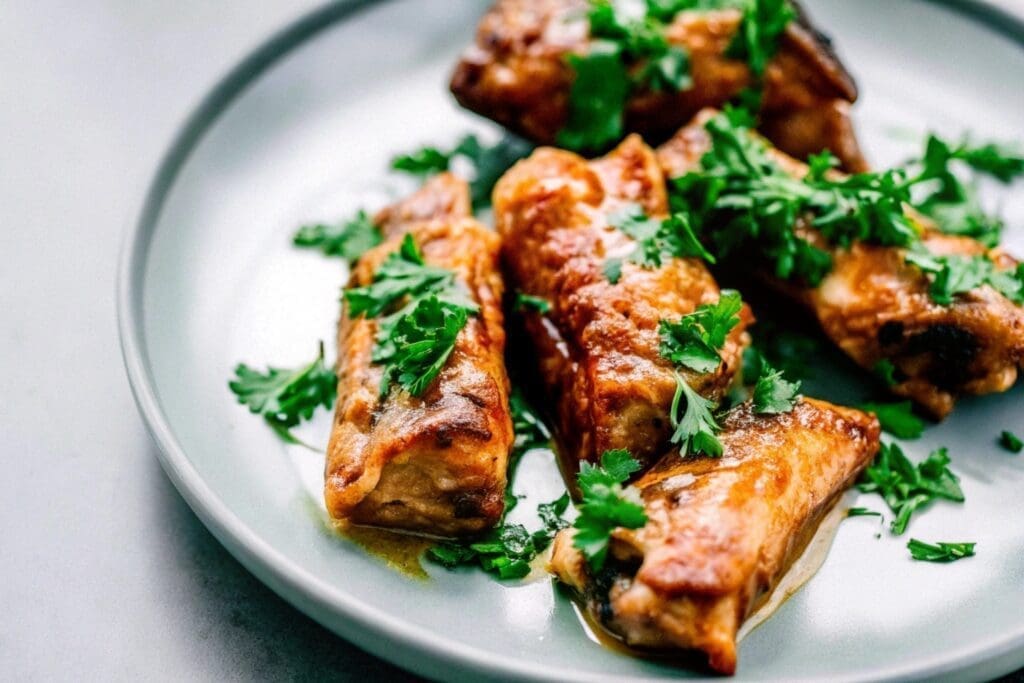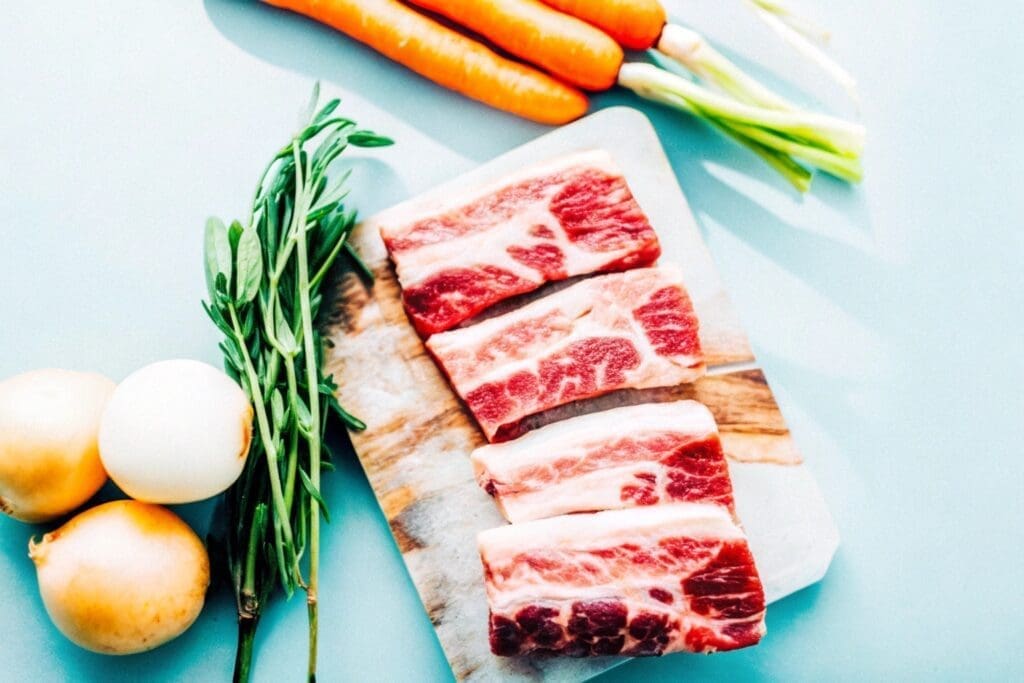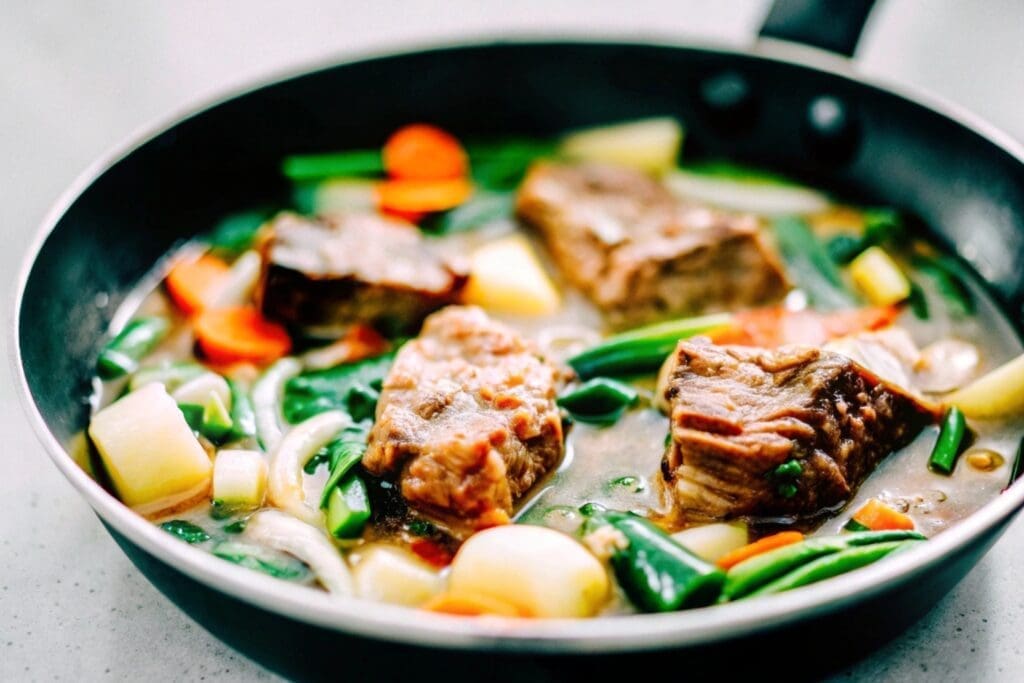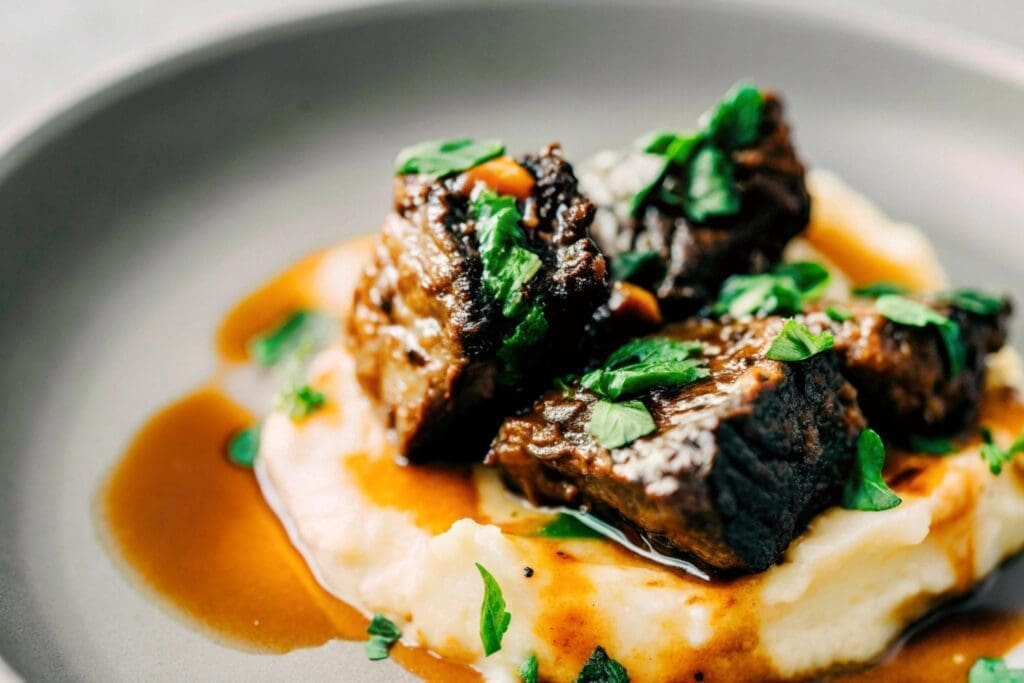Imagine a dish so rich, tender, and satisfying that it instantly becomes the highlight of any meal. That’s exactly what a boneless beef short ribs recipe brings to the table. These melt-in-your-mouth ribs are perfect for cozy family dinners, entertaining guests, or even meal prepping for the week. With the right techniques and ingredients, you can create a restaurant-worthy meal in your own kitchen.
In this article, we’ll dive deep into every aspect of crafting the perfect short ribs, from selecting the meat to adding your personal twist. Ready to get started? Let’s unlock the secrets to this flavorful delight!

Ingredients for the Best Boneless Beef Short Ribs Recipe
To make the perfect boneless beef short ribs recipe, you’ll need a mix of simple, flavorful ingredients that work together to enhance the rich taste of the meat. Here’s everything you need:
| Ingredient | Quantity | Notes |
|---|---|---|
| Boneless beef short ribs | 2–3 lbs | Look for well-marbled cuts for maximum flavor. |
| Olive oil | 2 tbsp | For searing the meat. |
| Onion | 1 large, diced | Adds sweetness and depth. |
| Garlic | 4 cloves, minced | Essential for aromatic flavor. |
| Beef broth | 2 cups | Provides a rich base for the sauce. |
| Tomato paste | 2 tbsp | Enhances the savory flavor. |
| Worcestershire sauce | 1 tbsp | Adds umami and complexity. |
| Red wine (optional) | 1 cup | For a richer, deeper sauce. |
| Carrots | 2 medium, sliced | For added texture and sweetness. |
| Celery | 2 stalks, sliced | Balances the sauce with earthy notes. |
| Bay leaves | 2 leaves | Brings out the savory profile. |
| Fresh thyme | 3–4 sprigs | For an herby, fragrant touch. |
| Salt and pepper | To taste | For seasoning the meat and sauce. |
Ingredient Breakdown
- Boneless Beef Short Ribs: These are the star of the dish. Their marbled fat ensures the meat stays juicy and flavorful when slow-cooked.
- Beef Broth and Tomato Paste: These create the base for a luscious sauce that soaks into the ribs.
- Red Wine (Optional): While optional, wine adds a beautiful depth and elegance to the dish. If you don’t want to use alcohol, simply replace it with extra beef broth.
- Aromatics and Herbs: Onions, garlic, thyme, and bay leaves work together to create a symphony of flavors.
- Vegetables: Carrots and celery not only provide additional texture but also subtly sweeten the sauce.

Step-by-Step Guide to Perfect Boneless Beef Short Ribs
Follow these detailed steps to create a boneless beef short ribs recipe that’s guaranteed to impress. Each step is designed to bring out maximum flavor and tenderness.
Step 1: Prepare the Meat
- Remove the boneless beef short ribs from the refrigerator and pat them dry with paper towels. This helps achieve a good sear.
- Season both sides generously with salt and pepper.
Step 2: Sear the Ribs
- Heat olive oil in a large, heavy-bottomed skillet or Dutch oven over medium-high heat.
- Add the ribs in batches, making sure not to overcrowd the pan. Sear each side for 2–3 minutes until browned. This caramelization locks in the flavor.
- Once browned, transfer the ribs to a plate and set aside.
Step 3: Sauté Aromatics
- In the same skillet, add the diced onion and cook for 3–4 minutes until softened.
- Add the minced garlic and cook for another 1–2 minutes until fragrant.
Step 4: Build the Sauce
- Stir in the tomato paste and cook for 1 minute to enhance its flavor.
- Pour in the red wine (if using), scraping the bottom of the skillet to deglaze and release all the flavorful bits. Let it simmer for 2 minutes to reduce slightly.
- Add the beef broth, Worcestershire sauce, bay leaves, and thyme sprigs. Stir to combine.
Step 5: Combine and Cook
- Return the seared ribs to the skillet, nestling them into the sauce.
- Add the carrots and celery around the ribs. Ensure everything is partially submerged in the liquid.
Step 6: Slow Cook for Tenderness
- Cover the skillet with a lid and reduce the heat to low. Alternatively, you can transfer everything to a preheated oven at 325°F (160°C).
- Cook for 2.5 to 3 hours, occasionally spooning sauce over the ribs. The meat is ready when it’s fork-tender and almost falling apart.
Step 7: Final Touches
- Discard the bay leaves and thyme sprigs. Adjust seasoning with salt and pepper as needed.
- If the sauce is too thin, let it simmer uncovered for a few minutes to thicken.
Step 8: Serve
- Plate the ribs with a generous serving of the sauce. Garnish with fresh thyme or parsley for a pop of color.
- Pair with creamy mashed potatoes, buttered noodles, or crusty bread to soak up every last bit of the delicious sauce.

The History Behind Boneless Beef Short Ribs
Boneless beef short ribs may feel like a modern gourmet dish, but their roots are deeply embedded in traditional cooking. Originating as a beloved cut in many global cuisines, short ribs have always been a staple of comfort food. Let’s dive into their journey.
A Culinary Heritage
Short ribs are derived from the chuck or plate section of the cow, known for its rich marbling and robust flavor. While bone-in short ribs are traditional, boneless variations have gained popularity for their convenience and versatility. Historically, tougher cuts like short ribs were considered less desirable and often reserved for slow-cooking methods. This approach allowed home cooks to transform them into melt-in-your-mouth delicacies. If you want to learn more about the preferred cooking method for boneless short ribs, check out Preferred Cooking Method for Boneless Short Ribs.
Global Variations
- Korean Cuisine: In Korea, “galbi” or short ribs are marinated in a soy-based sauce and grilled, creating a smoky, caramelized flavor profile.
- French Influence: The French have mastered the art of braising short ribs, often pairing them with red wine and aromatic herbs to create dishes like “bœuf bourguignon.”
- American Barbecue: Short ribs, including boneless versions, are smoked and slathered in barbecue sauce, celebrated for their bold, hearty flavors.
Modern-Day Appeal
Today, boneless beef short ribs have found their way into high-end restaurants and home kitchens alike. Thanks to their adaptability, they can be cooked in countless ways, from braising to sous vide. This particular recipe draws inspiration from global techniques, combining the richness of braising with the simplicity of home cooking. For more ideas on how to smoke meat to perfection, explore The Best Temperature to Smoke Meatloaf Like a Pro.
Fun Fact: Did you know that short ribs were once considered a “butcher’s cut,” often kept by butchers for themselves due to their incredible flavor?
Creative Ways to Customize Your Boneless Beef Short Ribs Recipe
One of the best parts of a boneless beef short ribs recipe is how versatile it can be. Whether you’re catering to dietary preferences or experimenting with bold flavors, this dish adapts beautifully. Here are some creative ideas to inspire you:
Variations for Different Flavors
- Asian-Inspired Short Ribs
- Replace red wine with soy sauce and rice vinegar.
- Add ingredients like ginger, star anise, and a touch of honey to create a sweet-savory glaze.
- Garnish with sesame seeds and green onions for a fresh finish.
- Mediterranean Twist
- Use a base of tomatoes, olives, and fresh oregano in the sauce.
- Serve with couscous or orzo for a Mediterranean flair.
- Spicy Tex-Mex Style
- Incorporate chipotle peppers in adobo sauce and cumin into the braising liquid.
- Serve with warm tortillas, avocado slices, and a sprinkle of cilantro for a taco-style meal.
Customizations for Dietary Needs
- Low-Carb Option
- Skip the carrots and thicken the sauce with xanthan gum or a keto-friendly thickener.
- Pair with cauliflower mash instead of potatoes.
- Gluten-Free Short Ribs
- Ensure the beef broth and Worcestershire sauce are certified gluten-free.
- Serve over a bed of creamy polenta or roasted vegetables.
- Vegetable-Forward Adaptation
- Bulk up the recipe with mushrooms, zucchini, or pearl onions for added texture and flavor.
Elegant Presentation Ideas
- Serve the ribs over truffle mashed potatoes for a gourmet touch.
- Plate the ribs individually with a drizzle of sauce, garnished with fresh microgreens.
- Use wide, shallow bowls to showcase the sauce and vegetables, creating a rustic but chic look.

FAQs About Boneless Beef Short Ribs and Cooking Tips
Here are answers to some frequently asked questions about preparing the perfect boneless beef short ribs recipe.
1. Can I use bone-in short ribs instead of boneless?
Yes, you can substitute bone-in short ribs for this recipe. Keep in mind that bone-in ribs may take slightly longer to cook but will add extra depth of flavor to the dish. For more insights on the differences between boneless and bone-in ribs, refer to Boneless Beef Ribs vs Short Ribs.
2. What’s the best way to store leftovers?
Allow the ribs to cool completely, then transfer them to an airtight container with the sauce. Refrigerate for up to 3 days or freeze for up to 3 months. Reheat gently on the stove to preserve the texture and flavor.
3. Can I make this recipe in a slow cooker?
Absolutely! After searing the meat and sautéing the aromatics, transfer everything to a slow cooker. Cook on low for 6–8 hours or on high for 3–4 hours. The meat will turn out just as tender and flavorful.
4. How do I know when the ribs are done?
The ribs are ready when they are fork-tender and nearly falling apart. If using a thermometer, the internal temperature should reach around 190–205°F (88–96°C) for optimal tenderness.
5. What sides go best with boneless beef short ribs?
Classic pairings include creamy mashed potatoes, buttered noodles, or roasted root vegetables. For a lighter option, serve the ribs with a crisp green salad or sautéed greens like spinach or kale.
Conclusion
A perfectly cooked boneless beef short ribs recipe is a culinary triumph, offering rich flavors and melt-in-your-mouth tenderness that elevate any meal. With the right ingredients and techniques, you can transform a simple cut of meat into a restaurant-quality dish that’s both comforting and impressive.
Whether you choose to stick with the classic recipe or explore creative variations like Asian-inspired flavors or Mediterranean twists, the possibilities are endless. This dish pairs beautifully with a wide range of sides, making it perfect for cozy family dinners, entertaining guests, or simply treating yourself.
Now it’s your turn to bring this recipe to life in your kitchen! Gather your ingredients, follow the step-by-step instructions, and enjoy the satisfaction of serving a truly memorable meal. Don’t forget to experiment and make the recipe your own. If you loved this recipe, explore our other hearty dishes for more inspiration.
Share your cooking experience in the comments and let us know your favorite variations. For more recipes like this, bookmark our site and join our newsletter for weekly updates.
Bon appétit!

